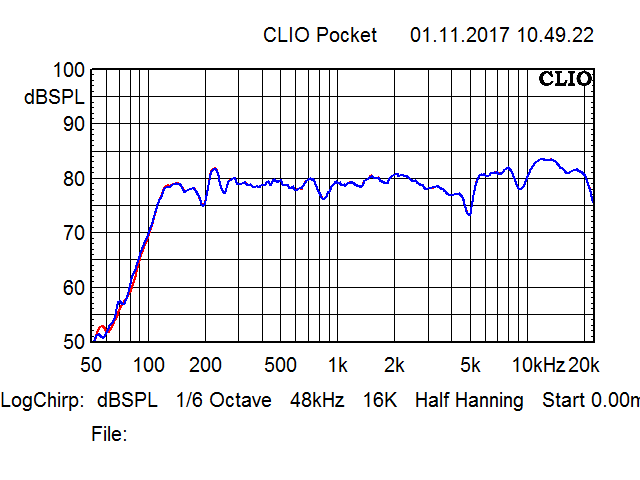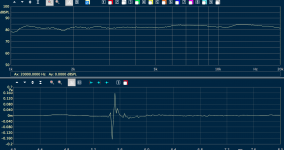Has anyone done that yet or knows the approx cost of this?You can upgrade it to USB for a fee.
I think not
Here 2 measurements, 1st Mic Senitivity set with 94, 2nd with 114 :

Don't understand what you mean ...
Of course you can measure the Mic sensitivity with an SPL calibrator, like this :
Galaxy Audio CM-C200
Regards Dirk
Pocket manual states
"Otherwise you may directly measure it provided you have a proper acoustical
calibrator and use the 1/2” adapter supplied with the MA-01 accessory kit:
In this case select the calibrator pressure used with the drop-down and, when
ready, press the Measure button to capture the microphone sensitivity."
One could read that to mean that the 94/114 selection only applies once you use the "measure" button and I'd assume it would fill in the sensitivity field accordingly.
I did a Clio Pocket mic frequency response calibration for a client recently, but both of us found out later that the Pocket does not support mic cal files. So that part of the Pocket is a bit lacking in functionality and clarity indeed.
Has anyone done that yet or knows the approx cost of this?
Answer from Audiomatica :
HARDWARE/SW UPGRADE 11 STND TO 12 STND euro 290 - plus Tax
Regards Dirk
Well then... Turns out you guys are schooling me on how CLIO Pocket works! 
You are absolutely correct about the 94dB/114dB selection in the options dialog box not making any difference when you manually enter a mV/Pa sensitivity. The mV/Pa quantity you manually enter must be the 94dB SPL sensitivity because that's how CLIO Pocket will interpret it.
The 94dB/114dB selection DOES function when you have a calibrator attached to your microphone and you click "Measure" to have CLIO Pocket automatically enter the measured sensitivity.
Thanks!
Also, on all this pricing stuff - I'm not trying to sell anything on this forum (especially if you already have a local distributor for Audiomatica or Outline), but you might have a look at my website's pricing page for everything I sell and convert it to euro's for comparison.
You are absolutely correct about the 94dB/114dB selection in the options dialog box not making any difference when you manually enter a mV/Pa sensitivity. The mV/Pa quantity you manually enter must be the 94dB SPL sensitivity because that's how CLIO Pocket will interpret it.
The 94dB/114dB selection DOES function when you have a calibrator attached to your microphone and you click "Measure" to have CLIO Pocket automatically enter the measured sensitivity.
Thanks!
Also, on all this pricing stuff - I'm not trying to sell anything on this forum (especially if you already have a local distributor for Audiomatica or Outline), but you might have a look at my website's pricing page for everything I sell and convert it to euro's for comparison.
Answer from Audiomatica :
HARDWARE/SW UPGRADE 11 STND TO 12 STND euro 290 - plus Tax
Regards Dirk
And QC guys have to fork out 450 Eur plus tax
+2 weeks lead time
And QC guys have to fork out 450 Eur plus tax
+2 weeks lead time
I haven't seen Audiomatica take more than 2 days to perform the upgrade after receiving the unit, but that's technically not a promise.
It's really an issue of the speed at which you choose to ship. In the US, I offer a free demo system (you can choose CLIO v10, v11 or 12) to cover your measurement needs while yours is making the trip. CLIO 12 and CLIO Pocket demos are available for free to people making a purchase decision as well of course.
Last edited:
Hello lholland, could I ask you, ifyou had enough time, just to measure TS parametres of any speaker,the same way as SB acoustic does.I haven't seen Audiomatica take more than 2 days to perform the upgrade after receiving the unit, but that's technically not a promise.
It's really an issue of the speed at which you choose to ship. In the US, I offer a free demo system (you can choose CLIO v10, v11 or 12) to cover your measurement needs while yours is making the trip. CLIO 12 and CLIO Pocket demos are available for free to people making a purchase decision as well of course.
Thank you.
Ah Langston, another question.
I intend to analyze a devices noise ratio.
But the default noise of the clio depends largely on the sensitivity settings, of course
If I go very high in sensitivity, the clio noise ends up at -140 or even -180. Is this still realistic then?
E.g. I could just lower the preamps output (the device I measure) to increase clio sensitivity to -40 and that would still show the noise of my preamp in case it had -120dBv?
cheers
Josh
PS: I'm asking cause the crappy old cheap plastic Technics SUC1000 (90s trash) I found as dummy in the basement, would have about 120dB SNR which sounds a little tooooo good for this thing.
I intend to analyze a devices noise ratio.
But the default noise of the clio depends largely on the sensitivity settings, of course
If I go very high in sensitivity, the clio noise ends up at -140 or even -180. Is this still realistic then?
E.g. I could just lower the preamps output (the device I measure) to increase clio sensitivity to -40 and that would still show the noise of my preamp in case it had -120dBv?
cheers
Josh
PS: I'm asking cause the crappy old cheap plastic Technics SUC1000 (90s trash) I found as dummy in the basement, would have about 120dB SNR which sounds a little tooooo good for this thing.
Last edited:
Found a potential improvement for the CLIO pocket software:
I got a highly sensitive audio system (1W/100dB) and my amps are driven by a very very low signal when doing clio measurements.
After doing a CLIO calibration, the CLIO software sets the output signal to the default of 1V
Trust me that one ***** his pants pushing the measure button (without noticing or resetting) with that setting on my system.
Would be great if the calibration routine stores the current output setting, then calibrates and grabs the original setting back into it again.
I got a highly sensitive audio system (1W/100dB) and my amps are driven by a very very low signal when doing clio measurements.
After doing a CLIO calibration, the CLIO software sets the output signal to the default of 1V
Trust me that one ***** his pants pushing the measure button (without noticing or resetting) with that setting on my system.
Would be great if the calibration routine stores the current output setting, then calibrates and grabs the original setting back into it again.
well regardless of someone being responsible himself of knowing which level hes about to run, especially on hi-spl horns  .....
.....
I absolutely agree! Many things in ClioPocket are restricted to have a cheap baby version of the pro - I can understand!
As long as this reduces the programming effort and support-model-tail behind.
But to me it accours that some things are just nuts, and annoying the user. Nothing is stored of the preferences, settings, even closing the custom-scaled waterfall window will open it reset to default when opening again (without restart of the app).
Seriously, this should be all stored in a config. Cant do that to the user. Each time you open the app, going through the same routine of setting 50 preferences.... nono
I absolutely agree! Many things in ClioPocket are restricted to have a cheap baby version of the pro - I can understand!
As long as this reduces the programming effort and support-model-tail behind.
But to me it accours that some things are just nuts, and annoying the user. Nothing is stored of the preferences, settings, even closing the custom-scaled waterfall window will open it reset to default when opening again (without restart of the app).
Seriously, this should be all stored in a config. Cant do that to the user. Each time you open the app, going through the same routine of setting 50 preferences.... nono
Pulse response
After changing the crossover and moving the tweeter in different positions I seem to have a reasonable pulse and response curve. My question now is, what is the perfect CLIO pulse and where can I find it or generate it to see how far off I am? (see attachment)
After changing the crossover and moving the tweeter in different positions I seem to have a reasonable pulse and response curve. My question now is, what is the perfect CLIO pulse and where can I find it or generate it to see how far off I am? (see attachment)
Attachments
It makes more sense to look at step response in case of loudspeaker.
Measuring Loudspeakers, Part Two Page 3 | Stereophile.com
The impulse of CLIO would be a very sharp and narrow peak going only in positive direction. You'll never get that with any loudspeaker.
If you use a loopback cable from out->in and run the measurement you'll see the CLIO's pulse
Measuring Loudspeakers, Part Two Page 3 | Stereophile.com
The impulse of CLIO would be a very sharp and narrow peak going only in positive direction. You'll never get that with any loudspeaker.
If you use a loopback cable from out->in and run the measurement you'll see the CLIO's pulse
It makes more sense to look at step response in case of loudspeaker.
Measuring Loudspeakers, Part Two Page 3 | Stereophile.com
The impulse of CLIO would be a very sharp and narrow peak going only in positive direction. You'll never get that with any loudspeaker.
If you use a loopback cable from out->in and run the measurement you'll see the CLIO's pulse
Thx!
Hi, i just asked the same and followed the recommendation for ultra small values to put a base resistor / capacitor or minicoil ahead of the cable. Really works!
Resolution of Clio is high but with cable only it doesnt show any value.
With my 3.3 cap it shows 3.3307 cap and 3.3315uF with cap+cable.
Cheers
Josh
Resolution of Clio is high but with cable only it doesnt show any value.
With my 3.3 cap it shows 3.3307 cap and 3.3315uF with cap+cable.
Cheers
Josh
Hi ..?
I just plugged a cap in series to the cable, between the alligators.
That lifts the capacity into higher range. Then u can switch one alligator to skip the cable and measure the cap only. The difference is your cable.
Indeed the difference is super small, and it makes sense, i do the same with cooking weight. so without cap its too close to the calibration tolerance of zero.
Lifting it with cap is like measuring the 3g oil in a 20g spoon
Cheers
Josh
I just plugged a cap in series to the cable, between the alligators.
That lifts the capacity into higher range. Then u can switch one alligator to skip the cable and measure the cap only. The difference is your cable.
Indeed the difference is super small, and it makes sense, i do the same with cooking weight. so without cap its too close to the calibration tolerance of zero.
Lifting it with cap is like measuring the 3g oil in a 20g spoon
Cheers
Josh
- Home
- Design & Build
- Equipment & Tools
- CLIO Pocket
